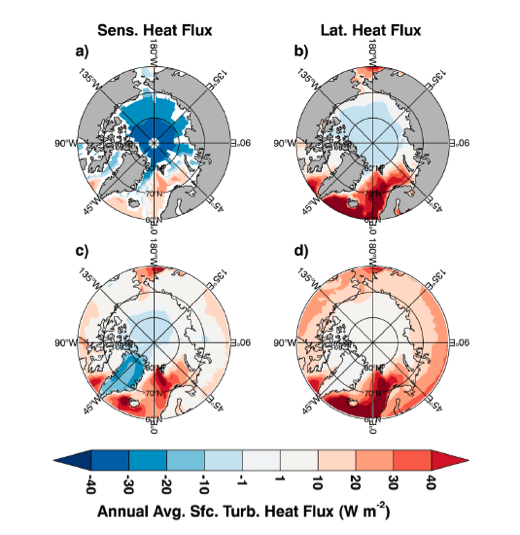Arctic sea ice reductions influence air-sea energy exchanges
The iconic image of rapid Arctic climate change is the dramatic reduction in sea ice. These reductions are more than just visual impressions but can dramatically alter the exchanges of mass, energy, and momentum between the atmosphere and ocean. The transfer of sensible heat and evaporation fluxes are particularly critical because they feed back on the atmospheric circulation, clouds, sea ice, temperature, and humidity. It is then critical to consider whether the observed and expected dramatic declines in Arctic sea ice are causing fundamental changes in sensible heat and evaporation fluxes and influencing the magnitude and form of Arctic amplification. In a new paper, researchers conclude that changes in sensible heat transfer and evaporation fluxes — in response to strong regional trends in the air-surface temperature contrast related to the changing character of the sea ice cover — are becoming increasingly consequential to Arctic climate variability and change. Moreover, significant trends in sensible heat and evaporation rates are evident in satellite-derived datasets, especially in the Barents-Kara Sea region in the fall due to increases in the air-sea temperature and humidity gradients, collocated with reductions in sea ice. This paper also assesses the diversity of model-simulated sensible heat and evaporation fluxes, revealing significant discrepancies in the Barents-Kara Sea region.

Arctic Ocean surface turbulent energy exchanges are not smooth and steady but rather irregular and episodic. In other words, a few significant, episodic, and highly non-linear events dominate air-sea sensible heat and water vapor fluxes. Future work must track how changes in sea ice and surface turbulent fluxes influence specific atmospheric regimes related to the episodic events. In the researcher’s assessment, the large uncertainty in future Arctic warming lies within the episodic bursts of energy from the Arctic Ocean to the atmosphere and how the ocean mixed layer, boundary layer structure, clouds, and the atmospheric circulation co-evolve. Consideration of the episodic nature of sensible heat and evaporation fluxes is essential for improving projections of Arctic climate.
1NASA Langley Research Center
2Science Systems Applications Inc.
3Earth System Science Interdisciplinary Center
Topics
- Sea Ice
- Satellites
- Ocean Heat
- Modeling
- Climate Change
- Arctic
- Air-Sea
